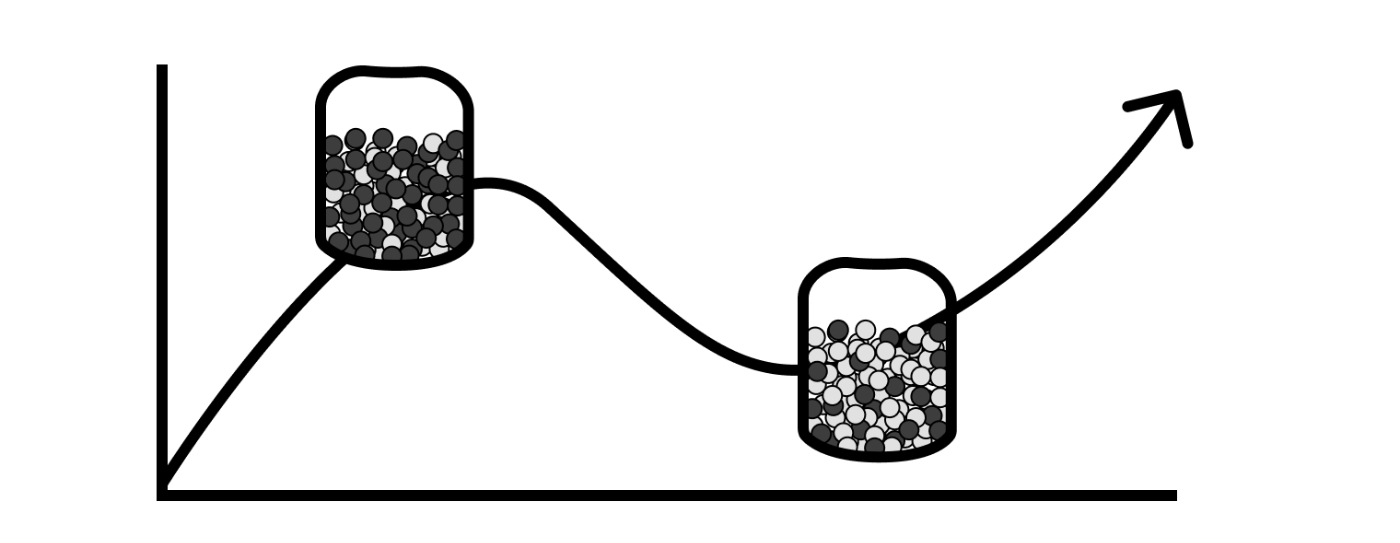
Sponsored By: Flatfile
Today's newsletter is brought to you by Flatfile, the customer data onboarding platform.
Clients can’t use your application without being able to populate their data, causing the CSV import problem to present itself at the most inopportune time—during onboarding.
Slash time-to-value, onboard customers faster, and cut product churn with a 1-click data import experience from Flatfile:
- Cut hours off data cleaning and focus on growing your company.
- Import customer data in less than 60 seconds.
- Migrate data using stringent compliance standards
Since launching in 2018, Flatfile has onboarded data for over 1.5 million customers spanning 400+ of the best companies around the world. In just a few clicks, Flatfile intelligently imports, transforms, and validates your customers’ data, solving the most critical part of onboarding, in seconds.
1
Howard Marks isn’t crazy about the title of his book, Mastering the Market Cycle. He actually said this in an interview. He thinks it promises too much. But his publisher told him to go with it, “because everybody will think they’ll figure out how to get rich.”
I share this anecdote because A) it’s hilarious, and B) it speaks to the central paradox of Marks’ thinking. Here is a man that explicitly attributes a great deal of his success (and there has been a lot of it; this is a guy who Warren Buffett reads for advice) to timing the market, but he doesn’t believe in predictions. He manages $120 billion in assets and talks at length about achieving superior returns by “positioning a portfolio for what’s ahead” but in practically the same breath says his favorite quote is “there are two kinds of forecasters: those who don’t know, and those who don’t know they don’t know.”
If I were a different kind of writer, I would probably just stop here and make fun of the guy. But the more I thought about the paradox, I went through a sequence of emotions that culminated in something like enlightenment. First I was annoyed that the book wasn’t giving me what it promised. It didn’t tell me how to call the bottom or top; he said it was impossible to do so. This was frustrating because, just as his publishers predicted, I was reading this book because I would like to be rich. Specifically, I would like to know what to do with my money right now. But then once I allowed the frustration to pass over and through me, what remained was curiosity. What was the actual point he was trying to make? How can you simultaneously reject predictions about market timing and claim that knowledge of market cycles is critical to improving your odds as an investor? I had to chew on this for a while, like a koan of capitalism. Only then, just as I was ready to give up, did enlightenment come.
2
Investing is, as Marks explains it, like reaching into a jar full of balls and betting on what color you’ll pick out.
(Huge missed opportunity to go with a “like a box of chocolates” Forrest Gump reference, if you ask me.)
The contents of the jar changes depending on which part of the market cycle we’re in. In a bull market, prices are high, and the odds are stacked against you. In a bear market, prices are low, so it’s much easier to make money.
We all know the idea: buy the dip, be greedy when others are fearful, etc.
The problem is that you can only know if you’re near the top or bottom in hindsight. Like I said in my post about the downturn in tech, people have been calling tech valuations a “bubble” ever since I joined the industry a dozen years ago. If you sat out this entire time you’d have missed out on one of the greatest bull runs in the history of investing. No matter how bad things get in the coming months and years, it’s highly unlikely to reset all the gains tech has made in the past 12 years. In other words: being early is the same as being wrong.
Which is why I wanted to read this book. And then I discover the guy who wrote the book on timing the market doesn’t believe in timing the market??
Turns out, there is a better way to think about investing, which resolves the contradiction.
3
First, abandon the desire to sell at the top and buy at the bottom. 99% of the time it will be a counter-productive impulse. Instead, seek to buy assets when you believe they are undervalued, and sell them when you think they are overvalued.
For example, let’s say you have done a lot of research on Peloton and you think they have a solid underlying business, they’ll be able to get out of their rough cash situation alive, and you think their pivot to software is a good idea. You study historical P/E ratios and come up with a number you think is fair for Peloton. Then you build in a margin of safety, in case you are wrong. If the stock is cheaper than the number you came up with, buy it. If it keeps getting cheaper despite no material change in the company’s circumstances, congrats, you get to buy more and push your average cost basis down even lower.
“This is just a basic description of value investing, and has nothing to do with market cycles,” you might object. And you’d be right, so far. But here’s where market cycles come into play: Marks would argue that knowing the current investor psychology helps you make better decisions.
If media and investors are fawning over Peloton, the price keeps hitting new highs, and the P/E ratio is way above historical norms, it provides a bit of an external sanity check on the analysis above. You can take it as a pretty good hint that the stock is not likely to be undervalued. Especially when it’s accompanied by other factors like a loose credit market, possible inflation, and many other stocks all surging at the same time.
Whereas if people are regularly calling into question Peloton’s very existence, activist investors are calling for the company to be sold and management to resign, amidst a backdrop of rising interest rates and huge losses across stocks broadly, there’s a much higher chance that you are getting a good deal.
The point isn’t to predict, it’s to take the current emotional temperature. It’s not to know where things will be tomorrow or next month, it’s to know what things are like today.
Of course, this isn’t a foolproof method. It’s entirely possible that Peloton will screw up the pivot, be unable to service their debt, and get sold for scraps to their creditors. The best we can do is control our downside risk and use knowledge of the current cycle to increase our odds of success.
4
It seems easy on paper: don’t worry about timing the market exactly, just do your own calculation of the value of an asset and buy when you think it is undervalued, which is likely to coincide with moments of fear and panic.
But how do you know when a valuation is reasonable? Startup valuations have steadily crept upward my whole career, then sort of exploded over the past few years. Same goes for public tech companies. And this all seemed semi-reasonable at the time, given that we had more and more evidence all the time that many of these businesses really did tend to become powerful profit machines. Shouldn’t a transformative new species of business warrant a deviation from historical P/E ratio norms?
Perhaps some, sure. But the question is how much. And how selectively this optimistic lens is applied. In reality, the numbers diverged by a lot, and there were tons of companies that got it that didn’t really deserve it. There were real estate and grocery and scooter businesses masquerading as software companies. This is where the historical perspective that Marks writes about comes in.
One of the most important skills in an investor’s repertoire is to sense the attitudes towards risk of market participants. This is almost impossible to do when you’re new, even if you read a lot of history. The only way to truly gain experience is to live through a few cycles up close, and see how investor’s perceptions of “reasonable risk” can change on a dime.
5
Overall, I came out of Mastering the Market Cycle feeling a bit conflicted.
On the plus side, it made me feel better about doing my research and picking a few companies I think are specifically undervalued, and only investing amounts I’m comfortable risking. It made me realize now is probably a good time to invest in index funds, but not to try and go all-in at the exact bottom, but rather to keep buying before, during, and after the date that will come to be seen as the bottom in retrospect. It also made me realize how patient I need to be—in the 2000 crash, it took years to recover and some great companies didn’t make it. On the other hand, Amazon, Microsoft, and Apple were incredibly cheap.
But on the other hand, I realized just how hard this stuff is. I feel like if I’m going to do it adequately, I would need to spend all my time reading. I now understand why Warren Buffett spends his time that way. When I watched an interview with Howard Marks where he wondered aloud why people don’t generally feel confident doing their own dentistry, but so many people think they can do their own investing, I have to admit it did make me pause.
I feel like I learned something, but I also feel like I learned just how much I don’t know. I guess this is what riding the Dunning-Kruger curve feels like.
Now I need to decide how much further I’m willing to go.
If you liked this, you should buy and read Mastering the Market Cycle.
Also, I’m trying something new. I wrote a chapter-by-chapter summary of the book along with my notes. Subscribers can access it here.
The Only Subscription
You Need to
Stay at the
Edge of AI
The essential toolkit for those shaping the future
"This might be the best value you
can get from an AI subscription."
- Jay S.
Join 100,000+ leaders, builders, and innovators

Email address
Already have an account? Sign in
What is included in a subscription?
Daily insights from AI pioneers + early access to powerful AI tools









Comments
Don't have an account? Sign up!